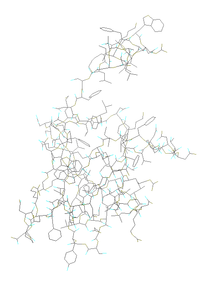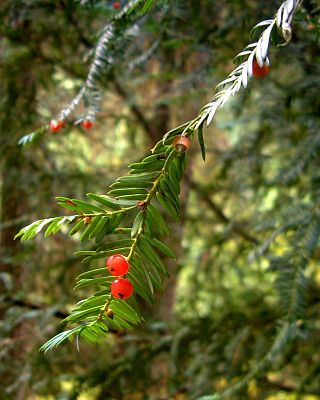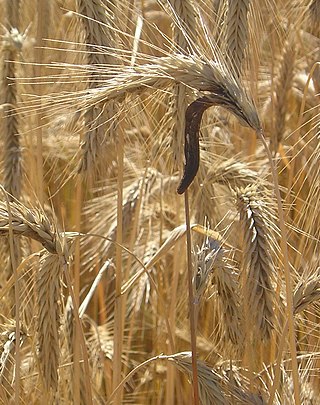Research and drug development
Cancer
There is no good evidence that any type of mushroom or mushroom extract can prevent or cure cancer. [4] [ better source needed ]
11,11'-Dideoxyverticillin A, an isolate of marine Penicillium, was used to create dozens of semi-synthetic, candidate anticancer compounds. [5] 11,11'-Dideoxyverticillin A, andrastin A, barceloneic acid A, and barceloneic acid B, are farnesyl transferase inhibitors that can be made by Penicillium. [6] 3-O-Methylfunicone, anicequol, duclauxin, and rubratoxin B, are anticancer/cytotoxic metabolites of Penicillium.[ citation needed ]
Penicillium is a potential source of the leukemia medicine asparaginase. [7]
Some countries have approved beta-glucan fungal extracts lentinan, polysaccharide-K, and polysaccharide peptide as immunologic adjuvants. [8]
Antibacterial agents (antibiotics)
Alexander Fleming led the way to the beta-lactam antibiotics with the Penicillium mold and penicillin. Subsequent discoveries included alamethicin, aphidicolin, brefeldin A, cephalosporin, [9] cerulenin, citromycin, eupenifeldin, fumagillin, [9] fusafungine, fusidic acid, [9] helvolic acid, [9] itaconic acid, MT81, nigrosporin B, usnic acid, verrucarin A, vermiculine and many others.

Antibiotics retapamulin, tiamulin, and valnemulin are derivatives of the fungal metabolite pleuromutilin. Plectasin, austrocortilutein, austrocortirubin, coprinol, oudemansin A, strobilurin, illudin, pterulone, and sparassol are under research for their potential antibiotic activity.[ citation needed ]
Cholesterol biosynthesis inhibitors

Statins are an important class of cholesterol-lowering drugs; the first generation of statins were derived from fungi. [10] Lovastatin, the first commercial statin, was extracted from a fermentation broth of Aspergillus terreus . [10] Industrial production is now capable of producing 70 mg lovastatin per kilogram of substrate. [11] The red yeast rice fungus, Monascus purpureus , can synthesize lovastatin, mevastatin, and the simvastatin precursor monacolin J. Nicotinamide riboside, a cholesterol biosynthesis inhibitor, is made by Saccharomyces cerevisiae .[ citation needed ]
Antifungals
Some antifungals are derived or extracted from other fungal species. Griseofulvin is derived from a number of Penicillium species; [12] caspofungin is derived from Glarea lozoyensis . [13] Strobilurin, azoxystrobin, micafungin, and echinocandins, are all extracted from fungi. Anidulafungin is a derivative of an Aspergillus metabolite.[ citation needed ]
Antivirals
Many mushrooms contain potential antiviral compounds remaining under preliminary research, such as: Lentinus edodes, Ganoderma lucidum, Ganoderma colossus, Hypsizygus marmoreus, Cordyceps militaris, Grifola frondosa, Scleroderma citrinum,Flammulina velutipes, and Trametes versicolor, Fomitopsis officinalis. [14] [15] [16] [17]
Immunosuppressants
Cyclosporin was discovered in Tolypocladium inflatum , while Bredinin was found in Eupenicillium brefeldianum and mycophenolic acid in Penicillium stoloniferum. Thermophilic fungi were the source of the fingolimod precursor myriocin. Aspergillus synthesizes immunosuppressants gliotoxin and endocrocin. Subglutinols are immunosuppressants isolated from Fusarium subglutinans . [18]
Malaria
Codinaeopsin, efrapeptins, zervamicins, and antiamoebin are made by fungi, and remain under basic research. [19]
Diabetes
Many fungal isolates act as DPP-4 inhibitors, alpha-glucosidase inhibitors, and alpha amylase inhibitors in laboratory studies. Ternatin is a fungal isolate that may affect hyperglycemia. [20]
Psychotropic effects
Numerous fungi have well-documented psychotropic effects, some of them severe and associated with acute and life-threatening side-effects. [21] Among these is Amanita muscaria, the fly agaric. More widely used informally are a range of fungi collectively known as "magic mushrooms", which contain psilocybin and psilocin. [21]
The history of bread-making records deadly ergotism caused by ergot, most commonly Claviceps purpurea , a parasite of cereal crops. [22] [23] Psychoactive ergot alkaloid drugs have subsequently been extracted from or synthesised starting from ergot; these include ergotamine, dihydroergotamine, ergometrine, ergocristine, ergocryptine, ergocornine, methysergide, bromocriptine, cabergoline, and pergolide. [22] [24]
Vitamin D2

Fungi are a source of ergosterol which can be converted to vitamin D2 upon exposure to ultraviolet light. [25] [26] [27]















